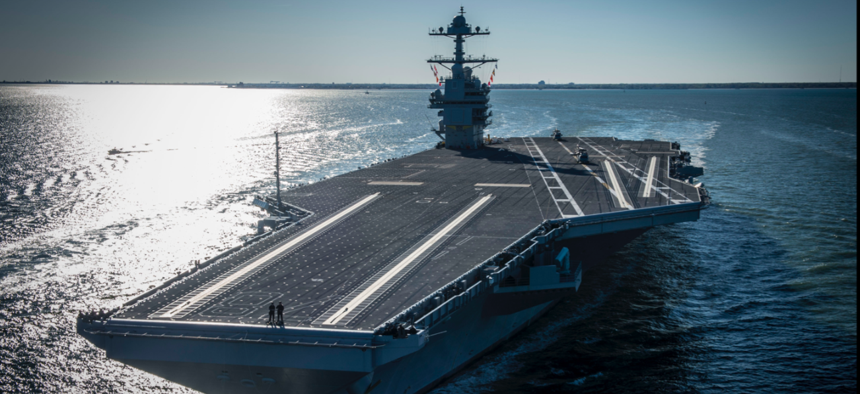
The future USS Gerald R. Ford (CVN 78) underway on its own power for the first time. U.S. Navy photo by Mass Communication Specialist 2nd Class Ridge Leoni
US Navy Places First 2-Carrier Order in Three Decades
Despite cost overruns on lead Ford-class ship, officials say dual buy will save $4 billion.
The U.S. Navy ordered two nuclear-powered aircraft carriers Thursday, the first time the Pentagon has placed a dual order for these types of ships since the 1980s.
The decision to buy two Ford-class carriers simultaneously — which service officials say will save taxpayers $4 billion — comes as the Navy still faces a host of problems with the Gerald Ford (CVN-78), the first ship in the class. But the service’s head of acquisition said that putting off the decision would have saved less money, because CVN-80 is already under construction.
“Had we’d waited a long period of time, the savings opportunity would have decreased because we would have already been well into construction and material purchase of CVN-80,” James “Hondo” Geurts said at a Thursday briefing at the Pentagon. “There was some urgency to fully capitalize on the savings potential for this two-carrier buy.”
Just hours before the deal was announced, the Pentagon’s director of operational test and evaluation released a report that said problems with multiple systems could limit the Gerald Ford’s ability to launch aircraft.
“Poor or unknown reliability of systems critical for flight operations including newly designed catapults, arresting gear, weapons elevators, and radar, could affect the ability of CVN-78 to generate sorties,” the report said.
Among the balky systems on the first-in-class Ford are the elevators that raise and lower weapons onto fighter jets, the catapults that launch planes, and the arresting cables that catch aircraft when they land. Geurts said the Navy has worked through most of the technical issues on the Ford.
“We’re confident in the overall design of the ship and the subsystems, [but there is] lots of work to go to prove those…and shake out reliability,” he said.
Together, the two aircraft carriers ordered on Thursday are expected to cost about $24 billion. The ships themselves — to be built by Huntington Ingalls Industries’ Newport News Shipbuilding — are expected to cost $15 billion. The remaining $9 billion is for what is known as government furnished equipment — systems such as radars — which the Navy purchases separately.
Navy officials say they are having fewer issues building the second Ford-class carrier, John F. Kennedy (CVN-79) and expect better results yet on the two ships purchased Thursday: Enterprise (CVN-80), and the as-yet-unnamed CVN-81. The two new ships are expected to enter the fleet in 2028 and 2032.
The expected $4 billion savings comes from buying material in quantities and allows Newport News Shipbuilding to maintain a “steady workforce,” Jennifer Boykin, president of Newport News Shipbuilding, said on a Thursday evening conference call after the contract announcement.
Or, as Geurts put it: “The savings are really because the shipyard can more effectively level load the workforce, we can get benefits of learning because we can more closely produce the same equipment, just produce it twice, and then we’ll get supplier benefits from being able to order that up front.”
Boykin said the deal “helps stabilize not only [the] Newport News Shipbuilding workforce, but that of our 2,000-member industrial base across 46 states.” She said it will also benefit other HII nuclear shipbuilding projects, including the Virginia-class and Columbia-class submarine programs because there will be no break in production between ships.
“From a materials standpoint, obviously, it is like going to Costco,” Boykin said. “We’re going into the supply base and we’re buying...two ship sets of the material we’re buying rather than one.”
The two-carrier orders of the 1980s saved 10 percent through such bulk purchases, Boykin said.
Geurts also said the deal is part of Navy’s response to the year-old National Defense Strategy, which focuses on about great-power competition with Russia and China.
“This is a great example of the Navy working hard to achieve the National Defense Strategy, which is deliver a lethal, capable force, but challenge ourselves to do so with all the reforms and innovation we know how to do,” he said.




